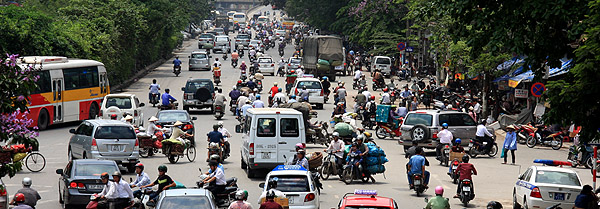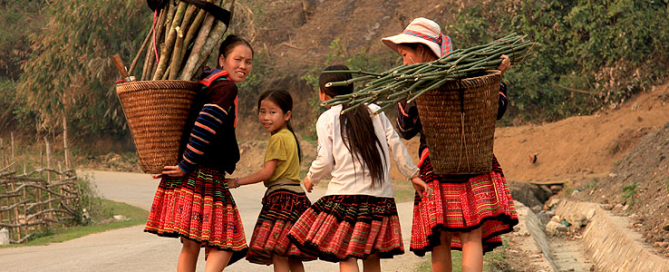Vietnam – 77,608 Km
When I arrived to the Vietnam immigration office I waited half an hour to be attended. Then, a young officer came to me and stamped my passport, although he was only interested in changing me money. So, after that I began to cycle downhill, it was 20 km of sharp bend, on a slope too steep and dangerous. After hard braking my wheels heated up, getting a puncture. That was the prize to all those days of cycling up in the mountainous area of Lao, something I will never forget.
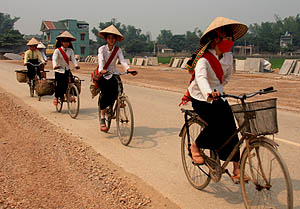
The route took me through a valley between green rice fields and small towns, where their people welcomed me with a warm smile or giving me a wave.
My first destination was the historic town of Dien Bien Phu, which is known to have been the scene of the battle between the Vietminh (League for the Independence of Vietnam led by Ho Chi Minh) and the French forces. The battle of Dien Bien Phu marked the beginning of the end of French Empire in Indochina, after nearly 100 years of domination, and led through the “The Geneva Conference” in the formation of North Vietnam and South Vietnam.
Still travelling with Guillerme, who cycled with me from Lao, we decided to rest for a couple of days in the city. There I looked for a mechanic for my bike but it was not easy, I had the feeling that nobody wanted to communicate with me by signs or even worse: to work. Communicating with people is a challenge, to ask about the road out of the city, to find a place to eat, to order food and even ask for the bill. And I get tired of it.
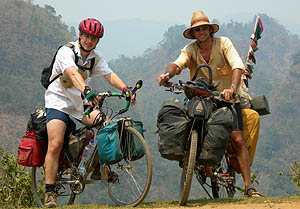
We left Dien Bien Phu to the north to enter into another mountainous area, with passes ranging from 1000 to 2200 mt. We almost always stopped in small towns or villages where we stayed in a hotel, which used to be more expensive than Lao hotels. But after the fatigue of the day we preferred to sleep in a bed and to eat at a restaurant, due to camping and cooking were more tiring and the day became endless. It was mid April and the weather was very hot. Idem than Lao, half of the route was under construction, the roads were dusty and with a lot of rocks which damaged our bikes. We had to carry several litres of water for long distances, but never were enough and some food because sometimes to reach to a town took us four or five hours. Almost every day we cycled two or three hours at night; my bike was heavier than ever and sometimes I had to drag it. At times I was absolutely worn out, I felt weak and thinner than ever. There were distances that we had to cycle 20 or 30 km up, and sometimes twice per day. Definitely this road demanded me as few places in my trip. It was a constant up and down.
During our tour we crossed different populations. In Vietnam there are more than 50 ethnic groups and most of them live in the northern mountainous area of the country. So, we met the Hmong, Muong, Dzao and Lahu, among others.


Their fields are on terraces, built in the mountains where they grow mainly rice and corn. They live in wooden houses and in a very primitive way; they are ruled by a chief and worship their ancestors. They also have their own language and women wear colourful traditional clothes and fine embroidery.

When we arrived to Sapa, Guillerme travelled to the capital city and returned to Canada, and I kept riding in the mountainous region for a few days more. Way to Bac Ha I had to cycle another 20 km up, and almost reaching the top I got a cramp in my leg as ever, I had to ask for help to get off the bike. I remember it was dark and it looked like it was going to rain; and therefore I dismissed the idea of camping. I was short 5 km to reach the city but I could hardly walk, and although I had a sharp pain in the leg I pushed the bike for a km and then I cycled down to the city. There I rested for several days in a nice hotel, eating well and giving myself massages on my legs.
During my stay in the mountains area, I visited the regional markets of Sapa, Can Cau and Bac Ha. These are fascinating open-air markets where the entire population use to go to sell their products ranging from food and clothing to homemade alcohol, or animals like buffaloes, chickens, horses, pigs and dogs.
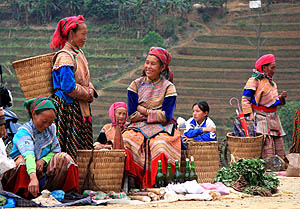

In Vietnam, as in China, Korea and the Philippines among other Asian countries, it is common the consumption of dog meat. On several occasions, while I was cycling across the country I saw some people who on their motorcycles carried dogs in cages, and according they explained to me, they were to eat. One day, in one of my stops on a secondary route I ordered a noodle soup which was accompanied with strange pieces of meat; it was too hard and with the skin of the animal. So, suspecting what it was about, I lost the appetite and on my third bite I stopped eating it, but I kept drinking the soup. Days later when I arrived in Hanoi, a friend told me that dog meat is often hard and it is served with the skin of the animal and it is believed that it enhances virility, it is a remedy against fatigue, low back pain and memory loss among other things, and that it increases sexual desire.
Way to Hanoi
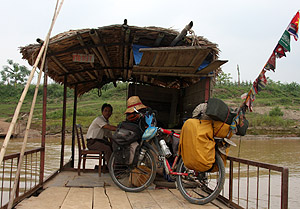
The road to Hanoi, the capital city, was not easy. On halfway, due to I wished to cycle along the river I left the main road and I took the old road that leads to the capital city, so I crossed the river by a raft and then going along it I crossed towns where there are very few vehicles and the graves of local people are hiding in their rice fields. But in a spite of I had three Vietnam maps I got lost several times. Each of them showed me different things. And people did not help me too much; on the contrary, they did my way more difficult. They touched everything of the bike, and if I didn’t stop them they ride it. Several times they touched my chest and arm hair and never lacked who tried to touch between my legs too. I remember when I was refused to eat in a restaurant, the reason “probably not stop playing cards.” Or worse, when after a strong rain I was soaked and I was refused to stay at the only hotel in the town. My God! Terrible rain…, so I had to keep cycling for another 20 km and the rain only stopped when I arrived to the next city, but this time, I was welcome. It happens in every country, I meet all kinds of people, the nicest and the others.
When I arrived to Hanoi, I stayed at a hotel in the old city, where his manager asked me “how many days are you planning to stay? No less than 10″ I answered him. And after arranging the price, I carried my entire luggage till the fourth floor through a narrow staircase. But on the sixth day, the guy ordered me to leave the hotel because he had the room booked.

But in Hanoi I also met nice people, as the Phoenix Team, representatives of Arcor from Argentina, who contributed with a donation, or the Argentine Ambassador Alberto Kaminker and Juan Manuel Cortelletti, the Consul. They helped me to extend the Vietnam visa and to get a new one for China. I also met the Argentineans football trainers and players in Vietnam, who took me for a walk at Vietnamese night. With Fernet Branca included.
During my stay in Hanoi I visited the museum of ethnology which introduces and shows the cultural characteristics of all the Vietnamese community. I also visited the Hoa Lo Prison Museum which I found funny, because part of the museum represents, through statues, the Vietnamese prisoners in the French colonial era, which are chained on wooden beds. Paradoxically, the other part shows through photos the treatment to the Americans prisoners of war by the Vietnamese, in which Americans are playing volleyball as if they were in a club.
I visited the Ho Chi Minh Museum too, the father of the Vietnamese nation.
During the last few days I toured Hanoi and its surroundings; I visited the Ba Dinh and Cau Giay neighbourhoods and the Hoan Kiem and Tay Ho lakes, and I cycled through the Long Bien bridge too. But the most amazing of the city is the two-wheeled traffic. According a friend explained me; the phenomenon of the motorcycles goes back to no more than 10 years, when most people rode their bicycles. Today every family has at least one or two motorcycles and everybody drive them, although not everyone knows to do it. Women are the worst, although men are more kamikazes than women. Usually nobody looks to the sides, everybody accelerate, pass furiously and block you. And one must guess what they will do. Cycling in Hanoi was an adventure and escape from an accident unharmed was a miracle.
